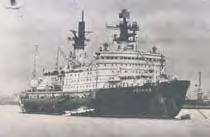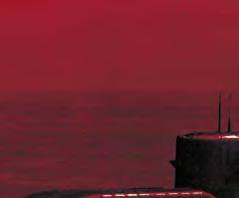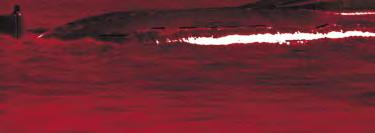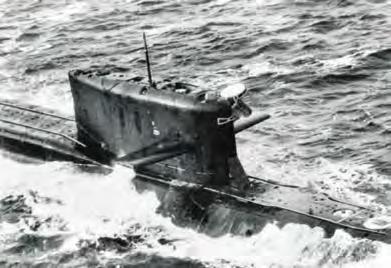
16 minute read
Cold War Strategic ASW
An Echo II missile submarine with four of her eight Shaddock missile canisters in the raised, launch position.
Cold War Strategic ASW Cold War Strategic ASW Photos courtesy of U.S. Naval Historical Center
Advertisement


Soviet strategic missile submarines were the greatest naval threat to the United States during the Cold War. Accordingly, strategic antisubmarine warfare (ASW) became a major role of the U.S. Navy, especially the attack submarines. This excerpt from Cold War Submarines: The Design and Construction of U.S. and Soviet Submarines by Normal Polmar and Kenneth J. Moore briefly describes the development of strategic ASW. Cold War Submarines was written in collaboration with the Rubin and Malachite design bureaus, which developed most of the Soviet submarine projects of the Cold War, as well as other Russian agencies. Mr. Polmar is a leading naval author, analyst, and historian; Mr. Moore, president of the Cortana Corporation, is a submarine technologist.
The appearance of the Project 667A/ Yankee (SSBN) strategic missile submarine had a profound impact on the U.S. Navy’s antisubmarine strategy. 1 Heretofore Western naval strategists looked at the Soviet submarine force as a reincarnation of the U-boat threat of two world wars to Anglo-American merchant shipping.
From the late 1940s, for two decades, the U.S. Navy contemplated an AntiSubmarine Warfare (ASW) campaign in which, in wartime, Soviet submarines would transit through “barriers” en route to attack Allied convoys in the North Atlantic and then return through those same barriers to rearm and refuel at their Arctic bases. These barriers – composed of maritime patrol aircraft and hunter-killer submarines guided or cued by the seafloor Sound Surveillance System (SOSUS) – would sink Soviet submarines as they transited, both going to sea and returning to their bases. 2 Also, when attacking
Allied convoys, the Soviet submarines would be subjected to the ASW efforts of the convoy escorts.
In reality, by the mid-1950s the Soviets had discarded any intention of waging an anti-shipping campaign in a new Battle of the Atlantic. The U.S. Navy’s development of a carrier-based nuclear strike capability in the early 1950s and the deployment of Polaris missile submarines in the early 1960s had led to defense against nuclear strikes from the sea becoming the Soviet Navy’s highest priority mission. New surface ship and submarine construction as well as land-based naval and, subsequently, Soviet Air Forces aircraft were justified on the basis of destroying U.S. aircraft carriers and missile submarines as they approached the Soviet homeland.
When the Project 667A/Yankee SSBNs went to sea in the late 1960s, the Soviet Navy was given another high-priority mission: Strategic (nuclear) strike against the United States and the protection of its own missile submarines by naval forces. The
Efforts to counter these submarines required the U.S. Navy to undertake a new approach to ASW. A variety of intelligence sources were developed to detect Soviet submarines leaving port, especially from their bases on the Kola Peninsula. These included High-Frequency Direction Finding (HF/DF) facilities in several countries, Electronic Intelligence (ELINT) intercept stations in Norway and, beginning in the 1950s, Norwegian intelligence collection ships (AGI) operating in the Barents Sea. 3 Commenting on the AGI Godoynes, which operated under the code name Sunshine in 1955, Ernst Jacobsen of the Norwegian Defense Research Establishment, who designed some of the monitoring equipment in the ship, said that the Godoynes – a converted sealer – was “bursting at the seams with modern American searching equipment, operated by American specialists.” 4 The Central Intelligence Agency sponsored the ship and other Norwegian ELINT activities. The Norwegians
The nuclear-propelled icebreaker ROSSIYA, as completed, with weapons and military electronics. Nuclear icebreakers may have provided a link between Soviet communication nets and submerged submarines.

Yankee SSBNs severely reduced the effectiveness of the U.S. Navy’s concept of the barrier/convoy escort ASW campaign. These missile submarines – which could carry out nuclear strikes against the United States – would be able to pass through the barriers in peacetime and become lost in the ocean depths, for perhaps two months at a time. Like the U.S. Polaris SSBNs, by going slow, not transmitting radio messages, and avoiding
Allied warships and shipping, they might remain undetected once they reached the open sea.
If the Soviets maintained continuous SSBN patrols at sea (as did the U.S. Navy) there would always be some ballistic missile submarines at sea. During a period of crisis, additional Soviet SSBNs would go to sea, passing through the barriers without Allied ASW forces being able to attack them. operated a series of AGIs in the ELINT role in the Barents Sea from 1952 to 1976. In the Pacific, there was collaboration with Japanese intelligence activities as well as U.S. HF/DF and ELINT stations in Japan to listen for indications of Soviet submarine sorties.


U.S. Submarines Keep Vigilant Watch U.S. Submarines Keep Vigilant Watch on Soviet Strategic Missile Submarines on Soviet Strategic Missile Submarines
From the early 1960s U.S. reconnaissance satellites also could identify Soviet submarines being prepared for sea. Once cued by such sources, SOSUS networks emplaced off the northern coast of Norway and in the Greenland-Iceland-United Kingdom (GIUK) gaps would track Soviet SSBNs going to sea. Presumably, SOSUS networks in the Far East were cued by similar ELINT and other intelligence sources.
Directed to possible targets by SOSUS, U.S. attack submarines would attempt to trail the ballistic missile submarines during their patrols. These SSBN trailing operations were highly sensitive and until of U.S. submarine operations, war plans, communications, and the SOSUS program. This source was John A. Walker; a Navy communications specialist who had extensive access to highly classified U.S. submarine material. Based on Walker’s data and other intelligence sources, the Soviets restructured their own naval war plans. The previous American perception was that the U.S. Navy would win “easily, overwhelmingly,” according to a senior U.S. intelligence official. 5 “From the late 1970s . . . we obtained special intelligence sources. They were available for about five years, until destroyed by [Aldrich] Ames and others.” Based on those sources, “we learned that there would be more holes in our submarines than we originally thought-we had to rewrite the war plan.” 6
the late 1970s were not referred to, in even top secret U.S. Navy documents. Navy planning publications – highly classified – began to discuss trailing operations at that time as the U.S. understanding of the Soviet submarine roles in wartime began to change.
Beginning in the late 1960s, the Soviet Union gained an intelligence source in the U.S. Navy that could provide details
In the mid-1980s U.S. officials began to publicly discuss the Western antiSSBN strategy. Probably the first official
pronouncement of this strategy was a 1985 statement by Secretary of the Navy John Lehman, who declared that U.S. SSNs would attack Soviet ballistic missile submarines “in the first five minutes of the war.” 7 In January 1986, the Chief of Naval Operations, Adm. James D. Watkins, wrote that “we will wage an aggressive operations were released: the trail of a Yankee SSBN in the Atlantic, 10 and that of a Project 675/Echo II SSGN in the Pacific by SSNs. 11 This particular Yankee trailing operation – given the code name Evening Star – began on March 17, 1978 when USS Batfish (SSN-681) intercepted a Yankee SSBN in the Norwegian Sea.
campaign against all Soviet submarines, including ballistic missile submarines.” 8 Earlier Watkins had observed that the shallow, ice-covered waters of the Soviet coastal seas were “a beautiful place to hide” for Soviet SSBNs. 9
Only in 2000 would the U.S. Navy reveal some of the details of trailing Soviet SSBNs. In conjunction with an exhibit at the Smithsonian Institution’s Museum of American History commemorating one hundred years of U.S. Navy submarines, heavily censored reports of two U.S. trailing

A Soviet Delta I SSBN on patrol.
Batfish, towing a 1,100-foot sonar array, had been sent out from Norfolk specifically to intercept the SSBN, U.S. intelligence having been alerted to her probable departure from the Kola Peninsula by the CIA-sponsored Norwegian intelligence activities and U.S. spy satellites. These sources, in turn, cued the Norway-based SOSUS array as the Soviet missile submarine sailed around Norway’s North Cape.
After trailing the Soviet submarine for 51 hours while she traveled 350 nautical miles, Batfish lost contact during a severe

storm on March 19. A U.S. Navy P-3 Orion maritime patrol aircraft was dispatched from Reykjavik, Iceland, to seek out the evasive quarry. There was intermittent contact with the submarine the next day and firm contact was reestablished late on March 21 in the Iceland-Faeroes gap.
The trail of the SSBN was then maintained by Batfish for 44 continuous days, the longest trail of a Yankee conducted to that time by a U.S. submarine. 12 During that period the Yankee traveled 8,870 nautical miles, including a 19-day “alert” phase, much of it some 1,600 nautical miles from the U.S. coast, little more than the range of the submarine’s 16 RSM-25/R-27U missiles. The Batfish report provides day-to-day details of the Yankee’s patrol and the trailing procedures. Significantly, the SSBN frequently used her MGK-100 Kerch active sonar (NATO designation Blocks of Wood). 13 This sonar use and rigidly scheduled maneuvers by the Soviet submarine, for example, to clear the “baffles,” that is, the area behind the submarine, and to operate at periscope depth twice a day continuously revealed her position to the trailing SSN. 14 Batfish ended her trailing operation as the Yankee SSBN reentered the Norwegian Sea.
The routine repetitiveness of the “target” was used to considerable advantage by Batfish. Certain maneuvers indicated

a major track change or impending periscope depth operations. But would such predictable maneuvers have been used in wartime? The repeated use of her sonar in the Batfish operation was highly unusual for a Yankee SSBN on patrol. Would the missile submarine have employed countermeasures and counter-tactics to shake off the trailing submarine during a crisis or in wartime? “You bet they would change their tactics and procedures,” said the commanding officer of the Batfish, Cmdr. Thomas Evans. 15
There are examples of tactics being employed by Soviet submarines to avoid U.S.-NATO detection. Among them have been transiting in the proximity of large merchant ships or warships in an attempt to hide their signatures from Western sensors, and reducing noise sources below their normal level when transiting in areas of high probability of SOSUS detection. 16 When the Russian cruise missile submarine Kursk was destroyed in August 2000, a Russian SSBN, believed to be a Project 667BDRM/Delta IV, may have been using the fleet exercise as a cover for taking up a patrol station without being detected by U.S. attack submarines in the area. (Another Delta IV, the Kareliya [K-18], was participating in the exercise at the time.)
Not all U.S. trailing operations were successful. Periodically Soviet SSBNs entered the Atlantic and Pacific without being detected; sometimes the trail was lost. A noteworthy incident occurred in October 1986 when the U.S. attack submarine Augusta (SSN-710) was trailing a Soviet SSN in the North Atlantic. Augusta is reported to have collided with a Soviet Delta I SSBN that the U.S. submarine had failed to detect. Augusta was able to return to port, but she suffered $2.7 million in damage. The larger Soviet SSBN suffered only minor damage and continued her patrol. (U.S. and Soviet submarines occasionally collided during this phase of the Cold War, many of the incidents undoubtedly taking place during trail operations. Unofficial estimates place the number of such collisions involving nuclear submarines at some 20 to 40.)
The limited range of the Yankee’s RSM25/SS-N-6 missile forced these submarines to operate relatively close to the coasts of the United States. Under these conditions, and upon the start of hostilities, the trailing U.S. submarines would attempt to sink


(top) A Soviet Yankee SSBN transiting on the surface. Yankees, designed for high speeds while submerged, could reach 25 knots
(bottom) An Echo II sail with radio antenna raised at the after end of the fairwater structure.
the Soviet SSBNs as they released their first missiles (or, under some proposals, when their missile tube covers were heard opening). If feasible, the U.S. submarines would call in ASW aircraft or surface ships, and there were proposals for U.S. surface ships to try to shoot down the initial missiles being launched, which would reveal the location of the submarine to ASW forces. These SLBM shoot-down proposals were not pursued. 17
U.S. anti-SSBN efforts again were set back in 1972 when the first Project 667B/ Delta I ballistic missile submarine went to sea. This was an enlarged Yankee design carrying the RSM-40/R-29 (NATO SS-N-8 Sawfly) missile with a range of 4,210 nautical miles. This missile range enabled Delta I SSBNs to target virtually all of the United States while remaining in Arctic waters and in the Sea of Okhotsk. In those waters the SSBNs could be defended by land-based naval aircraft as well as submarines and (in ice-free waters) surface warships. These SSBNs were equipped with a buoy-type surfacing antenna that could receive radio communications, target designations, and satellite navigational data when the ship was at a considerable depth.
Further, communications with submarines in Arctic waters were simplified because of their proximity to Soviet territory. The use of surface ships and submarines for communications relay were also possible. It was possible that civilian nuclearpropelled icebreakers – which were armed on their sea trials – were intended to provide such support to submarines in wartime. 18
Also, having long-range missiles that would enable SSBNs to target the United States from their bases or after short transits, fit into the Soviet Navy’s procedure of normally keeping only a small portion of the submarine fleet at sea, with a majority of their undersea craft held in port at a relatively high state of readiness. These submarines – of all types – would be “surged” during a crisis.
This procedure was radically different than that of the U.S. Navy, which, for most of the Cold War, saw up to one-third of the surface fleet and many SSNs forward deployed. More than one-half of the SSBN force was continuously at sea – nautical at a cost of more personnel and more wear-andtear on the ships.
The Soviet SSBN operating areas in the Arctic and Sea of Okhotsk-referred to a “sanctuaries” and “bastions” by Western intelligence-were covered by ice for much of the year and created new challenges for Western ASW forces. U.S. attack submarines of the Sturgeon (SSN-637)-class were well suited for operating in those areas, being relatively quiet and having an under-ice capability. 19 However, the Arctic environment is not “ASW friendly”: communications – even reception – are extremely difficult under ice; passive sonar is degraded by the sounds of ice movement and marine life; and under-ice acoustic phenomena interfere with passive (homing) torpedo guidance. Also, the Arctic environment, even in ice-free areas, is difficult if not impossible for Allied ASW aircraft and surface ship operations.
The Soviet SSBN force thus became an increasingly effective strategic strike/deterrent weapon, especially when operating in the sanctuaries or bastions.
(c) 2003 N. Polmar and K. J. Moore, Cold War Submarines (Dulles, VA: Brassey’s - Potomac Books).
Bibliography
1) The first major studies of this subject to appear in public were Donald C. Daniel, Anti-Submarine Warfare and Superpower Strategic Stability (Urbana: University of Illinois Press, 1986), and Tom Stefanick, Strategic Anti-Submarine Warfare and Naval Strategy (Lexington, Mass.: Lexington Books, 1987).
2) The term SOSUS, believed to have been coined in 1952, was itself classified until about 1967; the unclassified code name Caesar was used as a cover name for production and installation of the arrays.
3) HF/DF - known as “huff-duff” - sought to detect Soviet submarine-to-shore communication to determine the location of submarines. The U.S. name for these facilities was Wullenweber, the name as well as the equipment being copied from the Germans; the Soviets had similar facilities to detect U.S. naval forces. HF/DF of submarine communications was a major factor in the Anglo-American victory over German Uboats in World War II.
4) Riste, The Norwegian Intelligence Service, p. 147.
5) Confidential source A discussion with N. Polmar, Washington, D.C., Aug. 22, 1997.
6) Ibid. Ames was a CIA counterintelligence officer who spied for the Soviets and, after the fall of the USSR, for Russia. When Ames was arrested in 1994, federal officials said that he had perpetrated the most costly break of security in CIA history. During at least nine years as a Soviet agent, he had revealed more than 100 covert operations and betrayed more than 30 operatives spying for the CIA and other Western Intelligence services.
7) Quoted in Melissa Healy, “Lehman: We’ll Sink Their Subs,” Defense Week (May 13, 1985), p. 18. One of the first meaningful public discussions of this subject was Capt. John L. Byron, USN, “No Quarter for Their Boomers,” U.S. Naval Institute Proceedings (April 1989), pp. 49-52.
8) Adm. James D. Watkins, “The Maritime Strategy,” supplement to the U.S. Naval Institute Proceedings (January 1986), p. 11.
9) George C. Wilson, “Navy Is Preparing for Submarine Warfare beneath Coastal Ice,” The Washington Post (May 19, 1983), p. A5.
10) From Commanding Officer USS Batfish (SSN-681), to Chief of Naval Operations (Op-095), Subj: Report of Mission LS-26, March 2-May 17, 1978; May 17, 1978, ser LS-26-D-0006-T-78. Also see Thomas B. Allen, “Run Silent, Run Deep,” Smithsonian Magazine (March 2001), pp. 51-61.
11) From Commanding Officer USS Guardfish (SSN-612), to Commander in Chief U.S. Pacific Fleet, Subj: Trail of Echo II nuclear submarine (Case Papa 07) during the period May 12-June 6, 1972; June 10, 1972, ser 00015-72.
12) USS Batfish report, Enclosure (1) “Abstract,” p. 1.
13) The active sonar was used every one to three hours through the Yankee’s transit to patrol area and while in the alert area; there was one three-day period when the sonar was not intercepted after the Yankee began the home transit; USS Batfish, Enclosure (1) “Abstract,” p. 7. The NATO term is derived from the “ping” of the active sonar, said to sound like the sharp clapping together of two blocks of wood.
14) Such baffle-clearing maneuvers at high speeds, sometimes involving a rapid descent to a deeper depth, are referred to as “crazy Ivan turns” by U.S. submarines.
15) Rear Adm. Thomas Evans, USN (Ret.), discussion with N. Polmar, Washington, D.C., Jan. 26, 2001.
16) See, for example, Milan Vego, Soviet Naval Tactics (Annapolis, Md.: Naval Institute Press, 1992), pp. 163-164, and B. N. Makeyev, Voyenno-morskiye aspekty national bezopasnosti (Naval Aspects of National Security) (Moscow: Nonproliferation and Critical Technologies Committee, 1997), pp.63-67.
17) As part of the U.S. Navy’s SSBN security program, the Anti-Launch phase Ballistic missile Intercept System (ALBIS) project culminated with the live firing of a Terrier surface-to-air missile against a submerged-launched Polaris A-2, reflecting a belief that the Soviets could employ a tactic. The attempted Polaris intercept failed.
18) One of the few discussions of these activities is N. Polmar and Raymond Robinson, “The Soviet Non-naval Force Multiplier,” U.S. Naval Institute Proceedings (December 1987), pp. 66-69. The large nuclear icebreakers Arktika and Rossiya were armed on their trials; the KGB Border Guard icebreakers were armed and other naval icebreakers had provisions for weapons and naval electronics.
19) The first 39 submarines of the subsequent Los Angeles (SSN-688)-class were not configured for underice operations.









